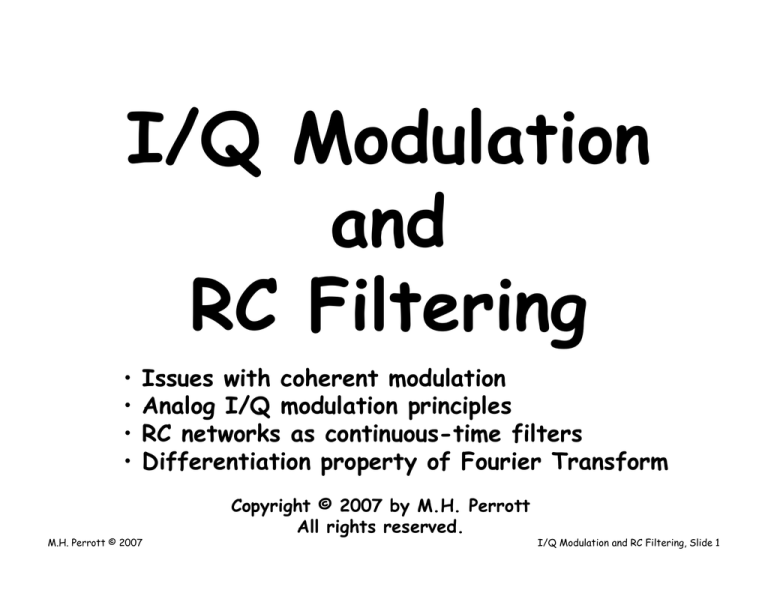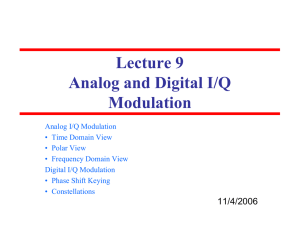
I/Q Modulation
and
RC Filtering
•
•
•
•
Issues with coherent modulation
Analog I/Q modulation principles
RC networks as continuous-time filters
Differentiation property of Fourier Transform
M.H. Perrott © 2007
Copyright © 2007 by M.H. Perrott
All rights reserved.
I/Q Modulation and RC Filtering, Slide 1
AM Modulation and Demodulation
Transmitter Output
x(t)
y(t)
Receiver Output
y(t)
w(t)
Lowpass
Filter
r(t)
H(f)
2cos(2πfot)
2cos(2πfot)
• Multiplication (i.e., mixing) operation shifts in
frequency
– Also creates undesired high frequency components at
receiver
• Lowpass filtering passes only the desired baseband
signal at receiver
What can go wrong here?
M.H. Perrott © 2007
I/Q Modulation and RC Filtering, Slide 2
Impact of 90 Degree Phase Shift
Transmitter Output
x(t)
y(t)
Receiver Output
y(t)
w(t)
Lowpass
Filter
r(t)
H(f)
2cos(2πfot)
2sin(2πfot)
• If receiver cosine wave turns into a sine wave, we
suddenly receive no baseband signal!
– We apparently need to synchronize the phase of the
transmitter and receiver local oscillators
• This is called coherent demodulation
• Some key questions:
– How do we analyze this issue?
– What would be the impact of a small frequency offset?
M.H. Perrott © 2007
I/Q Modulation and RC Filtering, Slide 3
Frequency Domain Analysis
W(f)
X(f)
H(f)
Y(f)
f
0
-fo
x(t)
y(t)
fo
0
Transmitter Output
1
-fo
0
-2fo
y(t)
f
-fo
0
r(t)
H(f)
1
fo
-fo
w(t)
2cos(2πfot)
2cos(2πfot)
1
f
fo
2fo
f
Receiver Output
Lowpass
Filter
1
0
fo
f
• When transmitter and receiver local oscillators are
matched in phase:
– Demodulated signal constructively adds at baseband
M.H. Perrott © 2007
I/Q Modulation and RC Filtering, Slide 4
Impact of 90 Degree Phase Shift
W(f)
X(f)
H(f)
Y(f)
f
0
-fo
x(t)
y(t)
fo
0
Transmitter Output
0
y(t)
-fo
w(t)
0
r(t)
H(f)
Lowpass
Filter
f
fo
Receiver Output
=0
j
1
-fo
-2fo
2sin(2πfot)
2cos(2πfot)
1
2fo
f
fo
f
f1
-f1
0
f
-j
• When transmitter and receiver local oscillators are
90 degree offset in phase:
– Demodulated signal destructively adds at baseband
What would happen with a small frequency offset?
M.H. Perrott © 2007
I/Q Modulation and RC Filtering, Slide 5
I/Q Modulation
1
Transmitter Output
It(f)
-fo
1
fo
0
f
f
Qt(f)
1
0
2cos(2πfot)
y(t)
2sin(2πfot)
qt(t)
j
-fo
component
1
fo
0
-fo
j
fo
0
f
Yq(f)
fo
f
-fo
Yi(f)
1
it(t)
0
I stands for
in-phase
1
0
f
-j
f
Q stands for
quadrature
component
-j
• Consider modulating with both a cosine and sine
wave and then adding the results
– This is known as I/Q modulation
• The I/Q signals occupy the same frequency band,
but one is real and one is imaginary
– We will see that we can recover both of these signals
M.H. Perrott © 2007
I/Q Modulation and RC Filtering, Slide 6
I/Q Demodulation
1
1
1
Transmitter Output
It(f)
-fo
1
fo
0
f
f
2sin(2πfot)
qt(t)
1
0
y(t)
2cos(2πfot)
Qt(f)
-fo
-fo
1
fo
0
j
fo
0
-j
Ir(f)
H(f)
f
y(t)
2cos(2πfot)
ir(t)
0
f
0
fo
-fo
0
f
Qr(f)
qr(t)
Lowpass
j
2
Lowpass
H(f)
-j
f
Receiver Output
f
2sin(2πfot)
fo
-fo
fo
0
Yq(f)
j
f
-fo
Yi(f)
1
it(t)
0
1
2
0
f
f
-j
• Demodulate with both a cosine and sine wave
– Both I and Q channels are recovered!
• I/Q modulation allows twice the amount of
information to be sent compared to basic AM
modulation with same bandwidth
What can go wrong here?
M.H. Perrott © 2007
I/Q Modulation and RC Filtering, Slide 7
Impact of 90 Degree Phase Shift
1
j
1
-fo
1
fo
0
f
f
Qt(f)
1
0
2cos(2πfot)
y(t)
2sin(2πfot)
qt(t)
j
-fo
-fo
1
fo
0
-fo
j
fo
0
-j
-j
H(f)
y(t)
Receiver Output
f
Ir(f)
ir(t)
0
2
Lowpass
2sin(2πfot)
0
H(f)
f
qr(t)
Lowpass
fo
-fo
0
-1
f
Qr(f)
-2cos(2πfot)
-j
f
0
f
Yq(f)
fo
f
-fo
Yi(f)
1
it(t)
0
fo
Transmitter Output
It(f)
f
0
f
-2
-1
• I and Q channels get swapped at receiver
– Key observation: no information is lost!
• Questions
– What would happen with a small frequency offset?
– What would happen with a large frequency offset?
M.H. Perrott © 2007
I/Q Modulation and RC Filtering, Slide 8
Summary of Analog I/Q Modulation
• Frequency domain view
Baseband Input
Receiver Output
It(f)
Ir(f)
1
it(t)
0
H(f)
f
2cos(2πfot)
2sin(2πfot)
Qt(f)
1
qt(t)
0
ir(t)
Lowpass
2cos(2πfot)
2sin(2πfot)
H(f)
f
0
f
Qr(f)
qr(t)
Lowpass
2
0
• Time domain view
Baseband Input
f
Receiver Output
t
t
it(t)
t
2cos(2πfot)
2sin(2πfot)
qt(t)
M.H. Perrott © 2007
2
H(f)
ir(t)
Lowpass
2cos(2πfot)
2sin(2πfot)
H(f)
Lowpass
qr(t)
t
I/Q Modulation and RC Filtering, Slide 9
R
Vin= cos(2πfot)
RC Filter
IR
C
Vout
Scope or
Spectrum
Analyzer
• Analyze by first deriving a differential equation
relating output and input voltages
• The filter frequency response is defined as
• The output voltage corresponds to a scaled and
phase shifted version of the input cosine wave
M.H. Perrott © 2007
I/Q Modulation and RC Filtering, Slide 10
Differentiation Property of FT
Fourier Transform
Definition
• Derive impact of differentiation
M.H. Perrott © 2007
I/Q Modulation and RC Filtering, Slide 11
Derivation of RC Filter Response
R
Vin
IR
C
Vout
Scope or
Spectrum
Analyzer
• Apply FT to above differential equation
• Filter frequency response is then calculated as
M.H. Perrott © 2007
I/Q Modulation and RC Filtering, Slide 12
Magnitude of RC Filter Response
R
Vin
IR
C
Vout
Scope or
Spectrum
Analyzer
• Define cutoff frequency of filter
• Magnitude of response:
H(f)
1
M.H. Perrott © 2007
1
2
-fc
0
fc
f
I/Q Modulation and RC Filtering, Slide 13
Summary
• Coherent modulation requires synchronized local
oscillators at transmitter and receiver
– Impact of phase offset is to change baseband amplitude
– Impact of frequency offset is fading (small offset) or
catastrophic corruption (large offset) of baseband signal
• I/Q modulation allows twice the amount of
information to be sent compared to basic AM
– Impact of phase offset is to swap I/Q
– Impact of frequency offset is I/Q swapping (small offset)
or catastrophic corruption (large offset) of received signal
• RC networks provide continuous-time filtering
• Upcoming lectures
– Examine another non-ideality: noise
– Lay groundwork for digital modulation and the concept of
information
M.H. Perrott © 2007
I/Q Modulation and RC Filtering, Slide 14




